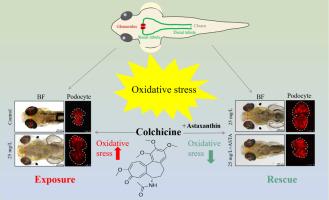Colchicine induces developmental defects and renal toxicity in zebrafish by upregulating the oxidative stress
IF 4.3
3区 环境科学与生态学
Q2 BIOCHEMISTRY & MOLECULAR BIOLOGY
Comparative Biochemistry and Physiology C-toxicology & Pharmacology
Pub Date : 2025-08-12
DOI:10.1016/j.cbpc.2025.110328
引用次数: 0
Abstract
Colchicine is a type of alkaloid commonly used clinically for treating diseases such as gouty arthritis. Studies suggest that colchicine is toxic to the kidneys. However, the specific mechanisms are unclear. Herein, we used zebrafish to validate the renal toxicity of colchicine and investigate the underlying mechanisms. Zebrafish larvae at 3 days post-fertilization were exposed to various concentrations (15, 20, and 25 mg/L) of colchicine solution for 72 h. Results showed that colchicine caused death, slowed heart rate, slowed growth, increased interpupillary distance, caused periorbital and renal capsule edema, caused swelling of glomerular podocytes, and disrupted the development of distal convoluted tubules of renal tubules. ROS staining revealed that colchicine increased oxidative in the glomerular. Mature zebrafish adults were exposed to colchicine solution concentrations of 0.15 and 1.5 mg/L for 4 weeks. Hematoxylin eosin staining of the kidney showed that the glomerular podocyte structure was disordered, renal tubular nuclei were irregularly arranged, and cell density was reduced. A significant increase in oxidative stress kinase activity was observed. Additionally, there was abnormal expression of genes related to kidney development and function. Abnormalities in kidney injury biomarkers were also observed in zebrafish, including urea nitrogen (BUN), creatinine (CR), and β-N-acetylglucosaminidase (NAG). These findings suggest that colchicine induced developmental defects and caused renal toxicity in zebrafish. Interestingly, treatment with astaxanthin (ASTA) partially reversed the structural and physiological damage in the kidney. Conclusively, colchicine induces developmental and renal toxicity in zebrafish by upregulating oxidative stress.

秋水仙碱通过上调氧化应激诱导斑马鱼发育缺陷和肾毒性。
秋水仙碱是临床上常用的一种生物碱,用于治疗痛风性关节炎等疾病。研究表明秋水仙碱对肾脏有毒。然而,具体机制尚不清楚。在此,我们用斑马鱼验证秋水仙碱的肾毒性,并探讨其潜在的机制。将受精后3 天的斑马鱼幼虫暴露在不同浓度(15、20和25 mg/L)的秋水仙碱溶液中72 h。结果显示秋水仙碱致大鼠死亡、心率减慢、生长减慢、瞳孔间距离增加、眼眶周围及肾包膜水肿、肾小球足细胞肿胀、肾小管远曲小管发育中断。ROS染色显示秋水仙碱增加肾小球氧化。成年斑马鱼暴露于浓度为0.15和1.5 mg/L的秋水仙碱溶液中4 周。肾苏木精伊红染色显示肾小球足细胞结构紊乱,肾小管核排列不规则,细胞密度降低。观察到氧化应激激酶活性显著增加。此外,与肾脏发育和功能相关的基因表达异常。在斑马鱼中也观察到肾损伤生物标志物的异常,包括尿素氮(BUN)、肌酐(CR)和β- n -乙酰氨基葡萄糖酶(NAG)。这些发现提示秋水仙碱可引起斑马鱼发育缺陷和肾毒性。有趣的是,虾青素(ASTA)治疗部分逆转了肾脏的结构和生理损伤。综上所述,秋水仙碱通过上调氧化应激诱导斑马鱼的发育和肾脏毒性。
本文章由计算机程序翻译,如有差异,请以英文原文为准。
求助全文
约1分钟内获得全文
求助全文
来源期刊
CiteScore
7.50
自引率
5.10%
发文量
206
审稿时长
30 days
期刊介绍:
Part C: Toxicology and Pharmacology. This journal is concerned with chemical and drug action at different levels of organization, biotransformation of xenobiotics, mechanisms of toxicity, including reactive oxygen species and carcinogenesis, endocrine disruptors, natural products chemistry, and signal transduction with a molecular approach to these fields.

 求助内容:
求助内容: 应助结果提醒方式:
应助结果提醒方式:


